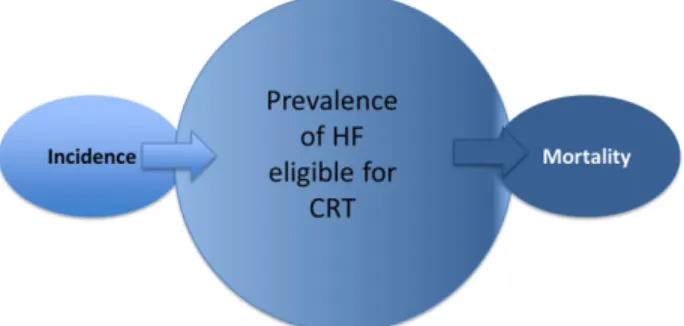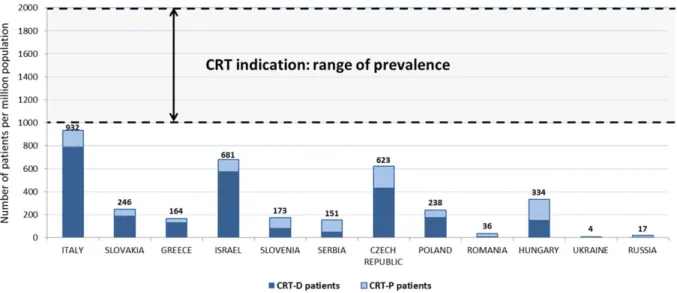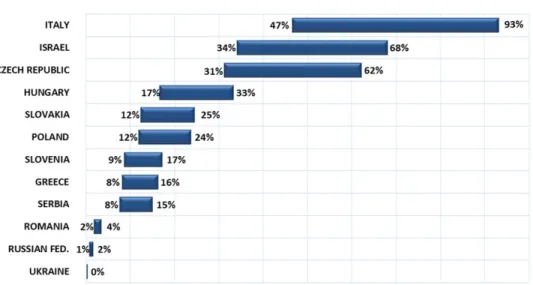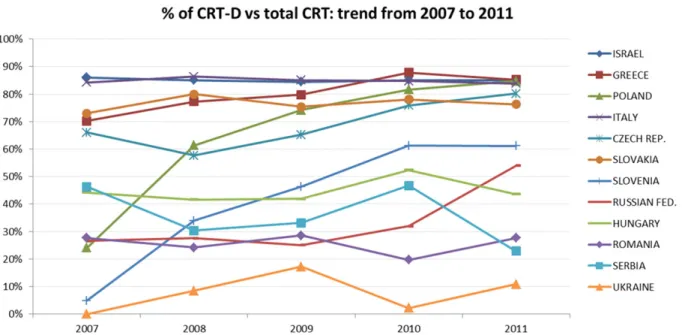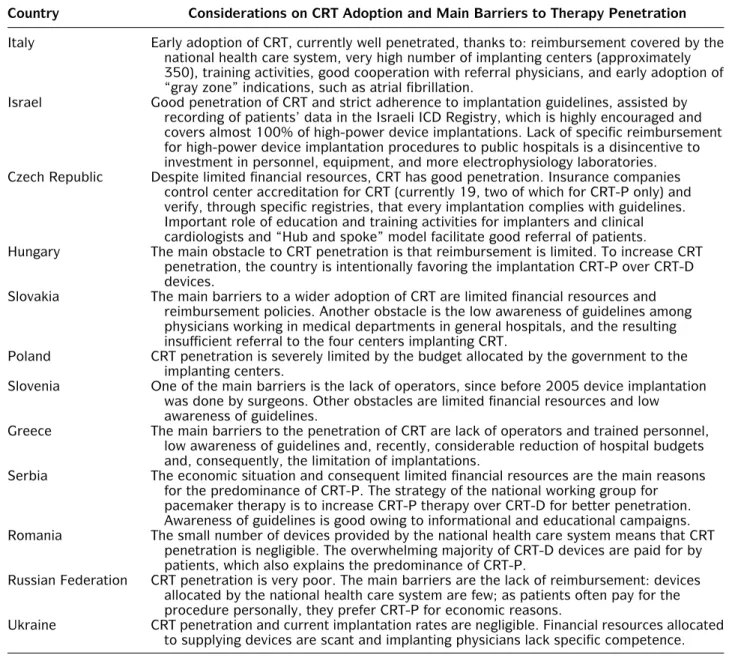Clinical Implementation of Cardiac Resynchronization Therapy—Regional Disparities across Selected ESC Member Countries
R. Hatala, M.D., ∗ M. Lunati, M.D.,† V. Calvi, M.D.,‡ S. Favale, M.D.,§
E. Goncalvesov´a, M.D., ∗ M. Haim, M.D.,¶ V. Jovanovic, M.D.,
∗∗K. Kaczmarek, M.D.,†† J. Kautzner, M.D.,‡‡ B. Merkely, M.D.,§§
E. Pokushalov, M.D.,¶¶ A. Revishvili, M.D.,
∗∗∗G. Theodorakis, M.D.,†††
R. Vatasescu, M.D.,‡‡‡ V. Zalevsky, M.D.,§§§ I. Zupan, M.D.,¶¶¶ I. Vicini, Dr.,
∗∗∗∗and G. Corbucci, Ph.D.
∗∗∗∗From the
∗National Cardiovascular Institute, Bratislava, Slovakia;
†Niguarda Hospital, Milano, Italy;‡CataniaUniversity Ferrarotto Hospital, Catania, Italy;
§University Hospital, Bari, Italy;¶Meir Medical Center, Kfar-Saba,Sackler Faculty of Medicine Tel-Aviv University, Israel;
∗∗Clinical Center of Serbia, Pacemaker Center, Belgrade, Serbia;
††Medical University of Lodz, Sterling University Hospital, Lodz, Poland; ‡‡Institute for Clinical andExperimental Medicine, Prague, Czech Republic; §§Heart Center, Semmelweis University, Budapest, Hungary;
¶¶State Research Institute of Circulation Pathology, Novosibirsk, Russian Federation;
∗∗∗Scientific Center for Cardiovascular Surgery, Moscow, Russian Federation;
†††Onassis Cardiac Surgery Center, Athens, Greece;‡‡‡Clinic Emergency Hospital, Bucharest, Romania; §§§Amosov National Institute of Cardiovascular Surgery,
Kiev, Ukraine; ¶¶¶University Medical Center, Ljubljana, Slovenia; and
∗∗∗∗Boston Scientific, Milano, Italy
Background: The present analysis aimed to estimate the penetration of cardiac resynchronization therapy (CRT) on the basis of the prevalence and incidence of eligible patients in selected European countries and in Israel.
Address for correspondence: Giorgio Corbucci, Boston Scientific S.p.A., Viale E. Forlanini 23, 20134, Milano, Italy. Fax: +39 02 26983248; E-mail: giorgio.corbucci@bsci.com
Funding: This work was supported by Boston Scientific Italy through the organization of a meeting and a web conference with all the investigators.
Conflict of interest:
R. Hatala reports research grants from Biotronik and Medtronic.
M. Lunati declares institutional research grants from Medtronic, St. Jude Medical, Sorin Group and Boston Scientific and consultancy/speaker fees from Medtronic, St. Jude Medical, Sorin Group, Boston Scientific, Biotronik, Boehringer-Ingelheim, and Sanofi-Aventis.
K. Kaczmarek reports medical consultant fees from Boston Scientific Poland and educational fees from Johnson & Johnson Poland and Medtronic Poland.
J. Kautzner is member of advisory board for Boston Scientific, Medtronic, and St Jude Medical and receives speaker honoraria from Biotronik, Boston Scientific, Medtronic, and St. Jude Medical.
B. Merkely reports lecture fee from Biotronik, Medtronic, St. Jude, and Boston Scientific and receives scientific grants from Biotronik, Medtronic, and St. Jude Medical.
V. Calvi. S. Favale, E. Goncalvesov ´a, M. Haim, V. Jovanovic, E. Pokushalov, A. Revishvili, G. Theodorakis, R. Vatasescu, V. Zalevsky, and I. Zupan have no conflict of interest to declare.
I. Vicini and G. Corbucci are employees of Boston Scientific Italy.
This is an open access article under the terms of the Creative Commons Attribution-NonCommercial-NoDerivs License, which permits use and distribution in any medium, provided the original work is properly cited, the use is non-commercial and no modifications or adaptations are made.
C2014 The Authors Annals of Noninvasive Electrocardiology Published by Wiley Periodicals, Inc.
DOI:10.1111/anec.12243
43
Methods and Results: The following countries were considered: Italy, Slovakia, Greece, Israel, Slovenia, Serbia, the Czech Republic, Poland, Romania, Hungary, Ukraine, and the Russian Federation. CRT penetration was defined as the number of patients treated with CRT (CRT patients) divided by the prevalence of patients eligible for CRT. The number of CRT patients was estimated as the sum of CRT implantations in the last 5 years, the European Heart Rhythm Association (EHRA) White Book being used as the source. The prevalence of CRT indications was derived from the literature by applying three epidemiologic models, a synthesis of which indicates that 10% of heart failure (HF) patients are candidates for CRT. HF prevalence was considered to range from 1% to 2%
of the general population, resulting in an estimated range of prevalence of CRT indication between 1000 and 2000 patients per million inhabitants. Similarly, the annual incidence of CRT indication, representing the potential target population once CRT has fully penetrated, was estimated as between 100 and 200 individuals per million. The results showed the best CRT penetration in Italy (47–93%), while in some countries it was less than 5% (Romania, Russian Federation, and Ukraine).
Conclusion: CRT penetration differs markedly among the countries analyzed. The main barriers are the lack of reimbursement for the procedure and insufficient awareness of guidelines by the referring physicians.
Ann Noninvasive Electrocardiol 2015;20(1):43–52 heart failure; cardiac resynchronization therapy; prevalence; incidence
Heart failure (HF) is a chronic progressive disease that results in substantial morbidity, mortality, and expenditure of health care resources.1, 2 Approximately 1–2% of the adult population in developed countries suffer from HF, with the prevalence rising toࣙ10% among persons 70 years of age or older.3Clinical trials have established that cardiac resynchronization therapy (CRT) improves the clinical outcomes of patients with HF, reduced left ventricular ejection fraction (LVEF) and left ventricular conduction delays.2 The European Society of Cardiology (ESC) Guidelines for the diagnosis and treatment of acute and chronic HF 20124 provide class I A recommendation for CRT treatment, with or without an implantable cardioverter defibrillator (ICD), in patients with symptomatic HF, sinus rhythm, QRS width ࣙ120 ms with left bundle branch block (LBBB) mor- phology and LVEF ࣘ35%. Although there has been a substantial increase in CRT implantation rates across Europe, marked differences among countries remain.5, 6 It is therefore likely that many patients who could potentially benefit from this therapy do not receive it. Since 2008, the European Heart Rhythm Association (EHRA) has published annual reports on CRT implantation rates in all represented countries.7 However, the penetration of CRT in comparison with the number of eligible patients has not been studied in detail.
The aim of the present analysis was to examine the penetration of CRT (with or without ICD) on the basis of the prevalence and incidence of CRT indications in a number of ESC member countries covering Central, Southern and Eastern Europe and Israel.
METHODS
The following countries were considered in the analysis: Italy, Slovakia, Greece, Israel, Slovenia, Serbia, the Czech Republic, Poland, Romania, Hungary, Ukraine, and the Russian Federation.
Each country was represented by a cardiologist, who actively contributed to the project.
CRT penetration was defined as the number of patients treated with CRT divided by the number of patients that, on the basis of ESC Guidelines class I A recommendation, should receive CRT; that is, the number of patients with a CRT implanted (CRT patients) in relation to the prevalence of CRT indications.
Assuming that the mean duration of recent CRT devices is 5 years,8the number of CRT patients was conservatively estimated as the cumulative num- ber of CRT implantations over 5 years (from 2007 to 2011), including replacements; this approximation minimizes the number of patients counted twice.
Both CRT-P (without ICD function) and CRT-D (with ICD function) were considered. The sources of data used for the analysis were the annual EHRA White Book reports.9All implantation rates were therefore cross-validated by the country coordinator.
The prevalence of CRT indication was derived from the literature; for simplicity, this was assumed to be constant over a period of a few years. This hypothesis is plausible, in that: (1) in the short term (5 years), HF prevalence is fairly stable;10 (2) the ratio between the incidence and prevalence of CRT indication is roughly 1:10, which is similar to the ratio between the incidence and prevalence of
Figure 1. Simplified hypothesis in which prevalence of CRT indication is constant, since the mortality rate is compensated by the incidence of new eligible subjects.
HF, as reported below; (3) as the annual mortality rate in CRT-indicated patients is about 10%,11 it approximately balances the incidence of new patients eligible for CRT. Figure 1 shows the simplified hypothesis, in which the prevalence of CRT indication is constant.
In order to estimate how many HF patients are indicated for CRT, three models were developed and compared:
r
Model 1 (based on a report from the Italian Network on Congestive Heart Failure published by Baldasseroni et al.12): patients with Sinus Rhythm, LBBB, and LVEF<30% represent 10.8%of HF patients.
r
Model 2 (based on a paper by Shenkman et al.13):among patients with HF, those with QRS duration
ࣙ120 ms and systolic dysfunction defined as LVEF<45% account for about 14.1%.
r
Model 3 (based on a report from the National Reg- istry to Advance Heart Health (ADVANCENT) published by El-Chami et al.14 and on data from the EuroHeart Survey15): 28.9% of systolic (LVEF ࣘ40%) HF patients have sinus rhythm and QRS ࣙ120 ms,14 and, since systolic HF patients represent 36% of all HF patients,15 CRT indication—defined as LVEFࣘ40%, sinus rhythm and QRSࣙ120 ms—is present in about 10.4% of HF patients.The consensus that emerges from the three models is that about 10% of patients with HF are indicated for CRT on the basis of current class I A guidelines.
Thus, considering that 1–2% of the general population is affected by HF,3 the prevalence of CRT indication in the general population is about
0.1–0.2%, which means 1000–2000 individuals per million population. This range can be defined as the full CRT penetration range.
Finally, calculations were made for the individ- ual participating countries. The demographics of each country were taken from The EHRA White Book.9 The estimated number of CRT patients in each country was normalized per million inhabitants, that is, calculated as the sum of the last 5 years implantation rates, each normalized for the current country population. For each country, the number of CRT patients was compared with the full CRT penetration range, and CRT penetration was estimated.
In the field of implantable devices, once full penetration has been reached, that is, all indicated patients have received implants, the potential target for the therapy becomes equal to the annual incidence rate of indication. Thus, the incidence represents the real number of patients to treat every year.
The HF incidence values reported in the literature range from 0.13% to 1.44% in the general population.3, 16–18 For simplicity, we estimated HF incidence in a range of 0.1–0.2%, as reported above. Thus, the annual incidence of CRT in- dication was estimated in a range of 100–200 individuals per million. For each country, the number of patients who underwent implantation in the year 2011 (normalized for resident population) was compared with the range of incidence of CRT indication.
Provided the prevalence of eligible patients with HF is completely covered by CRT implants, the annual CRT implantation rate should fall into that range. This means that approximately all new pa- tients indicated for CRT receive the therapy, which could be regarded as an ideal condition. When the penetration of CRT is partial, that range represents a minimum target. Achieving this target means that all newly eligible subjects, and possibly a portion of the remaining HF patients, will receive treatment.
RESULTS
Demographic and CRT implantation data in the various countries from 2007 to 2011 are shown in Table 1. Absolute and normalized EHRA White Book implantation data9 are reported. The last column displays normalized implantation data validated by the country’s investigator, which were
Table1.PopulationandAnnualCRTImplantRatesNormalizedperMillionInhabitantsofEachCountry EHRAWhiteNormalizedEHRANormalizedValidated DemographicsBookImplantDataWhiteBookDataImplantationData CountryYearPopulationCRT-PCRT-DCRTCRT-PCRT-DCRTCRT-PCRT-DCRT Italy200758,147,7331537820097372614116726141167 200858,145,3211500950011,0002616318926163189 200958,145,3211550880010,3502715117827151178 201060,748,965180010,00011,8003016519430165194 201161,016,804200010,38012,3803317020333170203 Slovakia20075,402,27330811116152161521 20085,455,407411642058303883038 20095,460,86272221293134054134054 20105,470,30689317406165874165874 20115,477,03878251329144660144660 Greece200710,964,020852383238222971623 200810,722,816902723628253472229 200910,733,53938642981536407672936 201010,749,943483233714303553439 201110,760,136323643963343753237 Israel20077,112,35979489568116980116980 20087,112,35912369982217981161798116 20097,233,2691548389922111613721116137 20107,353,985105720825149811225142167 20117,473,05210052762713718427154181 Slovenia20072,009,245392411912019120 20082,007,7113719561892818928 20092,005,703363167181533181533 20102,003,136365793182846182846 20112,000,092355590172745172745 Serbia20077,600,00011095205141327141327 20087,413,882158692272193121931 20097,376,81317386259231235231235 20107,344,84773641371091910919 20117,310,555226672933194031940 CzechRepublic200710,391,130313608921305989305989 200810,220,9114926691.16148651144865114 200910,210,6905511.0331.5845410115554101155 201010,201,7073019471.24830931223093122 201110,190,2132891.1711.4602811514328115143 Poland200738,518,2414401405801141511415 200838,500,6965178211.338132135132135 200938,500,6966061.7412.347164561164561 201038,463,6894311.9132.344115061115061 201138,441,5883872.1522.539105666105666 (Continued)
Table1.Continued EHRAWhiteNormalizedEHRANormalizedValidated DemographicsBookImplantDataWhiteBookDataImplantationData CountryYearPopulationCRT-PCRT-DCRTCRT-PCRT-DCRTCRT-PCRT-DCRT Romania200722,246,8628934123426426 200822,246,862752499314314 200922,224,61510040140426426 201021,959,2781714221382108210 201121,904,5511596122073107310 Hungary20079,956,108275218493282250282250 20089,930,915304217521312252312252 20099,901,122389281670392868392868 20109,992,339396436832404483404483 20119,976,062454352806463581463581 Ukraine2007NANANANANANANA000 2008NANANANANANANA101 2009NANANANANANANA101 201045,415,59645146101101 201145,134,70749655101101 RussianFederation2007140,702,09416660226102102 2008140,702,094322123445213213 2009139,998,584346116462213213 2010139,390,205317149466213213 2011138,739,892365428793336336
Figure 2.Estimate of patients already treated with CRT in each country compared with the possible range of patients indicated for therapy, both normalized per million population (range depending on the HF prevalence range).
used to estimate CRT penetration. Figure 2 shows the numbers of patients in whom CRT-P and CRT- D devices were implanted from 2007 to 2011 in each country. The range of CRT indication prevalence represents the estimated range of subjects that should be treated, according to the guidelines. For comparison between countries, both data are normalized per million inhabitants.
The estimated CRT penetration in each country is shown in Figure 3. The range is calculated on the basis of HF prevalence, which is between 1% and 2% of the general population.
Figure 4 shows the number of patients treated with CRT in each country from 2007 to 2011, normalized per million population, compared with the range of CRT indication incidence; the latter represents the number of new patients annually eligible for CRT and is also normalized per million inhabitants (range depending on the HF incidence range, estimated at 0.1–0.2% of the general population).
Italy is the country where CRT has the highest penetration: from 47% to 93% of patients indicated already have a device implanted. On the basis of the simplified model adopted, this means that, in the coming years, the number of CRT implantations should reach a value equal to the CRT indication incidence, which is estimated to be in the range of 100–200 implantations per million population.
Israel and the Czech Republic also display a good degree of therapy penetration, ranging from 34%
to 68% and from 31% to 62%, respectively. If maintained, the trend in CRT implantations seen in both countries in recent years will probably lead to greater penetration of the therapy in the near future.
CRT penetration is still only partial in Hungary, where less than one of three indicated patients is treated. The figures are even lower in Slovakia and Poland, where only one of four receives the therapy. As the implantation rate in these countries is still low, CRT penetration will probably slowly improve in the near future.
In Slovenia, Greece, and Serbia, more than 80%
of indicated patients are still not treated, and CRT adoption in recent years has also been very low.
In Romania, the Russian Federation and Ukraine, CRT penetration is very poor, since less that 5% of patients that could benefit from the therapy are currently treated, and implantation rates are negligible.
The number of CRT-D devices as a percentage of total CRT implants is seen to have varied year by year in the different countries, as shown in Figure 5. In Italy and Israel, the proportion of CRT-D devices exceeds 80%, and has remained stable over the last 5 years. Slovakia, Greece, the Czech Republic, and Poland currently adopt CRT- D in more than 75% of cases, with the last two countries showing an increasing trend year by year. In Slovenia, CRT-D devices are increasing and currently account for about 60% of all CRT implants. In the Russian Federation, Hungary,
Figure 3. Estimated CRT penetration range in each country, represented as a range depending on the HF prevalence range.
Figure 4.Number of patients treated with CRT in each country from 2007 to 2011, compared with the range of CRT indication incidence, which represents the number of new patients annually eligible for CRT; both are normalized per million inhabitants (range depending on the HF incidence range).
Romania, Serbia, and Ukraine, CRT-P devices are mainly used.
The main barriers to CRT penetration—as identified by the physicians representing each country—are summarized in Table 2.
DISCUSSION
In the present study, we estimated the potential population eligible for CRT on the basis of HF epidemiology and, for the first time, we evaluated the penetration of CRT in terms of prevalence and incidence in different countries.
According to current ESC guidelines, CRT is fully recognized as having a class I indication, level of evidence A, for patients with symptomatic HF, LVEF ࣘ35%, sinus rhythm, and cardiac dyssynchrony, which is currently defined as QRS duration ࣙ120 ms. The potential CRT target has been estimated by Linde at al.,19 who concluded that approximately 0.1% of the adult population should receive a CRT device. This percentage is consistent with our estimate of CRT indication prevalence. However, our study is the first to estimate CRT penetration, defined as the number of patients with a device already implanted as a proportion of the eligible population. Furthermore,
Figure 5.CRT-D devices as a percentage of total CRT implants in each country from 2007 to 2011.
considering that, once CRT has fully penetrated, the potential target for the therapy is equal to the annual incidence of CRT indication, we also estimated the incidence of CRT indication, defined as the annual number of new patients eligible for CRT, and compared this with annual implantation rates. This number is extremely important since it approximately represents the annual number of patients that we will be called to treat in the years to come. Finally, this analysis showed that, while CRT is universally accepted as a therapy for HF, there are significant differ- ences in terms of penetration among the various countries considered.
FACTORS AFFECTING DIFFERENCES IN CRT PENETRATION AND
OPPORTUNITIES TO PROMOTE CRT ADOPTION
There are many reasons for the disparities in CRT penetration observed in different countries.
Reimbursement by the national health care system for CRT device implantation seems to be an essential requirement for adequate adoption of the therapy; in countries where the cost of the procedure is not reimbursed or is only partially reimbursed, CRT penetration is very low and the
use of CRT-P devices is predominant. The issue of the cost-effectiveness of CRT has been addressed in several papers.20, 21 CRT-P appears to be a highly cost-effective addition to medical therapy in eligible patients, while CRT-D is cost-effective when life expectancy at the time of implantation is reasonable. Indeed, CRT has been shown to be cost-effective even in the ninth decade.21However, the problem is that cost-effectiveness analysis is difficult to transfer from one country to another, especially when the costs of labor, drugs, and medical devices vary significantly. Therefore, it is important to obtain country-specific data, since such data could convince governments to allocate health resources differently and/or prompt local health care insurers to reimburse CRT.
Another important factor in the adequate adop- tion of CRT is the availability of qualified personnel and the equipment required for successful im- plantation (C arm with the possibility of cine-loop acquisition, etc.). In some countries, the training of specialists remains a substantial issue. Training fellowships granted by the EHRA and/or organized directly by industry may help in this direction.
The adoption of CRT also depends on the awareness of physicians and patients. It is therefore of the utmost importance to “educate” referring physicians and to establish referral pathways.
Campaigns to raise public awareness of CRT are another important component of this process.
Table 2. Considerations and Main Barriers to Therapy Adoption in Each Countries
Country Considerations on CRT Adoption and Main Barriers to Therapy Penetration Italy Early adoption of CRT, currently well penetrated, thanks to: reimbursement covered by the
national health care system, very high number of implanting centers (approximately 350), training activities, good cooperation with referral physicians, and early adoption of
“gray zone” indications, such as atrial fibrillation.
Israel Good penetration of CRT and strict adherence to implantation guidelines, assisted by recording of patients’ data in the Israeli ICD Registry, which is highly encouraged and covers almost 100% of high-power device implantations. Lack of specific reimbursement for high-power device implantation procedures to public hospitals is a disincentive to investment in personnel, equipment, and more electrophysiology laboratories.
Czech Republic Despite limited financial resources, CRT has good penetration. Insurance companies control center accreditation for CRT (currently 19, two of which for CRT-P only) and verify, through specific registries, that every implantation complies with guidelines.
Important role of education and training activities for implanters and clinical cardiologists and “Hub and spoke” model facilitate good referral of patients.
Hungary The main obstacle to CRT penetration is that reimbursement is limited. To increase CRT penetration, the country is intentionally favoring the implantation CRT-P over CRT-D devices.
Slovakia The main barriers to a wider adoption of CRT are limited financial resources and reimbursement policies. Another obstacle is the low awareness of guidelines among physicians working in medical departments in general hospitals, and the resulting insufficient referral to the four centers implanting CRT.
Poland CRT penetration is severely limited by the budget allocated by the government to the implanting centers.
Slovenia One of the main barriers is the lack of operators, since before 2005 device implantation was done by surgeons. Other obstacles are limited financial resources and low awareness of guidelines.
Greece The main barriers to the penetration of CRT are lack of operators and trained personnel, low awareness of guidelines and, recently, considerable reduction of hospital budgets and, consequently, the limitation of implantations.
Serbia The economic situation and consequent limited financial resources are the main reasons for the predominance of CRT-P. The strategy of the national working group for pacemaker therapy is to increase CRT-P therapy over CRT-D for better penetration.
Awareness of guidelines is good owing to informational and educational campaigns.
Romania The small number of devices provided by the national health care system means that CRT penetration is negligible. The overwhelming majority of CRT-D devices are paid for by patients, which also explains the predominance of CRT-P.
Russian Federation CRT penetration is very poor. The main barriers are the lack of reimbursement: devices allocated by the national health care system are few; as patients often pay for the procedure personally, they prefer CRT-P for economic reasons.
Ukraine CRT penetration and current implantation rates are negligible. Financial resources allocated to supplying devices are scant and implanting physicians lack specific competence.
STUDY LIMITATIONS
The main limitation of the present study is that estimates of CRT penetration and of the prevalence and incidence of CRT indication are expressed as a wide range. This is due to the fact that both the prevalence and the incidence of HF are reported as wide ranges in epidemiologic studies. Since the prevalence of HF ranges from 1% to 2%, the estimated penetration of the therapy ranges from one percentage value to another which is twice as high; although this does not affect comparisons
among countries, the accuracy of the estimated CRT penetration in any single country is low.
Once further epidemiologic studies have better determined the value of HF prevalence, the present analysis will be able to provide a more accurate estimate of CRT penetration.
Another limitation of the present analysis is that we used rough HF prevalence and incidence values, which were not adjusted for age. Thus, comparisons among countries considered the same range of prevalence and incidence of CRT indication in all cases. Since HF is highly correlated
with age,3 the age distribution of the population will presumably influence the estimated range CRT indication in terms of prevalence and incidence, and consequently the estimate of CRT penetration.
For example, 26% of the Italian population is older than 60 years, while in the Russian Federation the figure is 18%.22A further analysis should consider the epidemiology of HF adjusted for age, in order to refine estimates of CRT penetration and better compare different geographic areas.
CONCLUSIONS
CRT penetration differs markedly among the countries analyzed. The main obstacles to patient recruitment are cultural and economic; cultural barriers are related to the awareness, dissemi- nation, and implementation of guidelines, while economic barriers are mainly related to the lack of reimbursement for the procedure in several countries.
Acknowledgments:We thank Seah Nisam for his contribution to the board meeting and paper review and Denis Losik, from Novosibirsk State Research Institute of Circulation Pathology, for his help in collecting implantation data from the Russian Federation.
We are grateful to Boston Scientific Italia, particularly to Sandro Borio, Stefania Faletra, Fabrizio Gemma, and Sergio Valsecchi, for their organizational support of the meetings.
REFERENCES
1. Lloyd-Jones D, Adams R, Carnethon M, et al. Heart disease and stroke statistics—2009 update: A report from the American Heart Association Statistics Committee and Stroke Statistics Subcommittee. Circulation 2009;119:e21–
e181.
2. Hunt SA, Abraham WT, Chin MH, et al. ACC/AHA 2005 guideline update for the diagnosis and management of chronic heart failure in the adult: A report of the American College of Cardiology/ American Heart Association Task Force on Practice Guidelines (Writing Committee to Update the 2001 Guidelines for the Evaluation and Management of Heart Failure): Developed in collaboration with the American College of Chest Physicians and the International Society for Heart and Lung Transplantation: Endorsed by the Heart Rhythm Society. Circulation 2005;112:e154–
e235.
3. Mosterd A, Hoes AW. Clinical epidemiology of heart failure.
Heart 2007;93:1137–1146.
4. McMurray JJV, Adamopoulos S, Anker SD, et al. ESC Guidelines for the diagnosis and treatment of acute and chronic heart failure 2012. The Task Force for the Diagnosis and Treatment of Acute and Chronic Heart Failure 2012 of the European Society of Cardiology. Developed in collaboration with the Heart Failure Association (HFA) of the ESC. Eur Heart J 2012;33:1787–1847.
5. van Veldhuisen DJ, Maass AH, Priori SG, et al. Implemen- tation of device therapy (cardiac resynchronization therapy and implantable cardioverter defibrillator) for patients with heart failure in Europe: Changes from 2004 to 2008. Eur J Heart Fail 2009;11:1143–1151.
6. Merkely B, Roka A, Kutyifa V, et al. Tracing the European course of cardiac resynchronization therapy from 2006 to 2008. Europace 2010;12:692–701.
7. Arribas F, Auricchio A, Wolpert C, et al. The EHRA White Book. Europace. 2012;14(Suppl 3):iii1–55.
8. Horlbeck F W, Mellert F, Kreuz J, et al. Real-world data on the lifespan of implantable cardioverter-defibrillators depending on manufacturers and the amount of ventric- ular pacing. J Cardiovasc Electrophysiol 2012;23:1336–
1342.
9. The EHRA White Books reports: Available at: http://www.
escardio.org/communities/EHRA/publications/Pages/white- book-project.aspx. Accessed October 15, 2012.
10. Go AS, Mozaffarian D, Roger VL, et al.; American Heart Association Statistics Committee and Stroke Statistics Subcommittee. Circulation 2013;127(1):e6–e245.
11. Curtis JP, Sokol SI, Wang Y, et al. The association of left ventricular ejection fraction, mortality, and cause of death in stable outpatients with heart failure. J Am Coll Cardiol 2003;42:736–42.
12. Baldasseroni S, Opasich C, Gorini M, et al.; Italian Network on Congestive Heart Failure Investigators. Left bundle- branch block is associated with increased 1-year sudden and total mortality rate in 5517 outpatients with congestive heart failure: A report from the Italian network on congestive heart failure. Am Heart J 2002;143(3):398–405.
13. Shenkman HJ, Pampati V, Khandelwal AK, et al. Congestive heart failure and QRS duration. Establishing prognosis study. CHEST 2002;122:528–534.
14. El-Chami MF, Brancato C, Langberg J, et al. QRS duration is associated with atrial fibrillation in patients with left ventricular dysfunction. Clin Cardiol 2010;33:132–
138.
15. Komajda M, Follath F, Swedberg K, et al.; Study Group on Diagnosis of the Working Group on Heart Failure of the European Society of Cardiology. The EuroHeart Failure Survey programme—A survey on the quality of care among patients with heart failure in Europe. Part 2: Treatment. Eur Heart J 2003;24:464–474.
16. Cowie MR, Wood DA, Coats AJ, et al. Incidence and aetiology of heart failure. A population-based study. Eur Heart J 1999;20:421–428.
17. Ho KK, Pinsky JL, Kannel WB, et al. The epidemiology of heart failure: The Framingham Study. J Am Coll Cardiol 1993;22(Suppl A):6A–13A.
18. Bleumink GS, Knetsch AM, Sturkenboom MC, et al. Quanti- fying the heart failure epidemic: Prevalence, incidence rate, lifetime risk and prognosis of heart failure. The Rotterdam Study. Eur Heart J 2004;25:1614–1619.
19. Linde C, Ellenbogen K, McAlister FA. Cardiac resynchro- nization therapy (CRT): Clinical trials, guidelines, and target populations. Heart Rhythm 2012;9:S3–S13.
20. Calvert MJ, Freemantle N, Yao G, et al. Cost effectiveness of cardiac resynchronization therapy: Results from the CARE- HF Trial. Eur Heart J 2005;26:2681–2688.
21. Yao G, Freemantle N, Calvert MJ, et al. The long-term cost- effectiveness of cardiac resynchronization therapy with or without an implantable cardioverter-defibrillator. Eur Heart J 2007;28:42–51.
22. http://www.census.gov/population/international/data/idb/
informationGateway.php. Accessed February 15, 2013.
